Anesthesia Theory of Operation
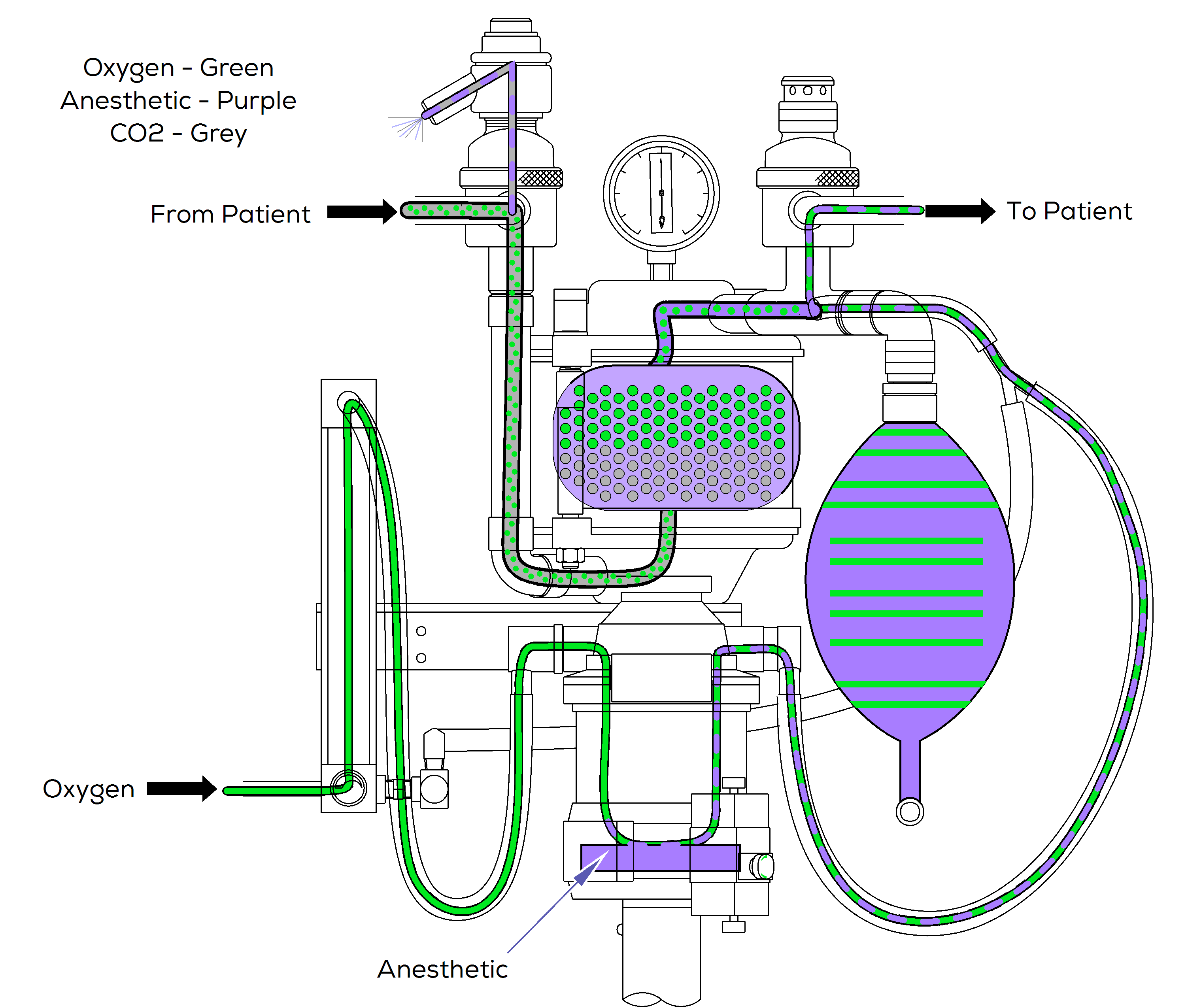
1.Oxygen enters the machine at the lower back of flowmeter.
2.Oxygen exits flowmeter near top.
3.The oxygen enters the vaporizer and collects anesthetic gas.
4.The oxygen and anesthetic exits the vaporizer.
5.Oxygen and anesthetic enters the reservoir bag and inhalation tube then is inhaled by the patient.
6.The patient exhales. Waste gas enters the machine.
7.Waste gas enters the CO2 absorber canister which removes the CO2.
8.Gas without CO2 enters the reservoir bag, inhalation tube and patient, recycling the gas.
9.A small amount of waste gas exits the APL valve, maintaining pressure in machine and patient’s lungs at 1-3cm H2O.
Analgesic compounds and oxygen administered through Matrx by Midmark Anesthesia Machines can be dangerous to patient and practitioner if stored, installed or administered improperly. Follow all protocols provided with these substances and associated delivery equipment.
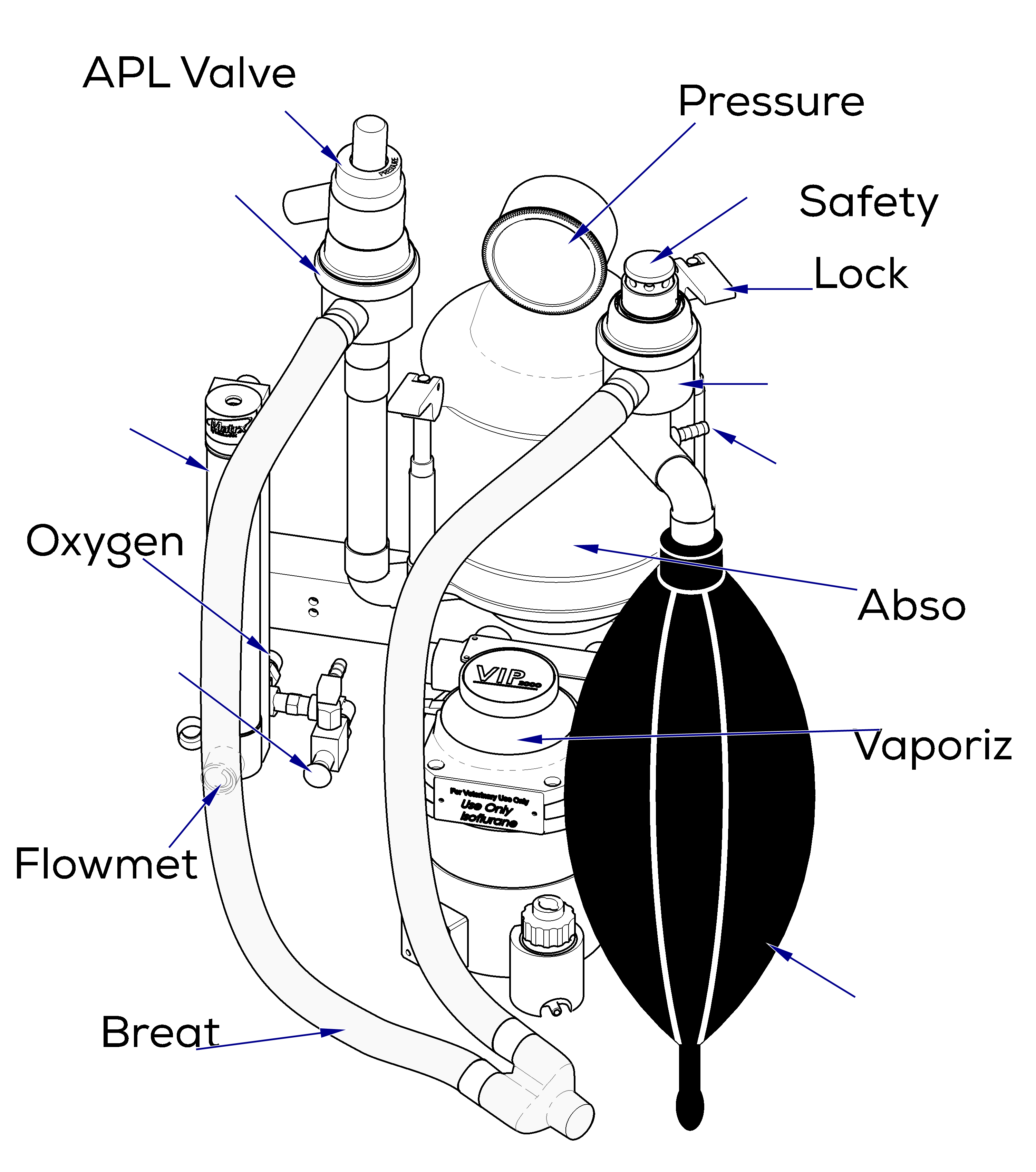
| Breathing Bag | |
|---|---|
| Patient Weight | Bag Size |
| 15 lbs or less (7kg) | 500 ml |
| 15-30 lbs (7-14 kg) | 1 liter |
| 30-60 lbs (14-27 kg) | 2 liter |
| 60-100 lbs (27-45 kg) | 3 liter |
| 100 + lbs (45 + kg) | 5 liter |
Ensure gas supplies are adequate and turned on. Verify vaporizer is filled to eliminate the possibility of anesthetic depletion during surgery.
Never invert or tilt the vaporizer when it contains anesthetic liquid. Never overtighten the flowmeter needle valves, damage to the needle and seat will eventually result. Using the flowmeter, pressure gauge, or pressure relief valve as handles when transporting can result in damage to components.
To Operate Anesthesia Machine
1.Lift CO2 absorber canister lock levers. Slide clear canister free of absorber assembly. Fill canister with absorbent material, following directions on canister label. Be sure canister and gasket mating surfaces are completely free of absorbent. Replace canister in absorber assembly. Simultaneously, close both lock levers to secure canister.
2.Connect breathing bag and breathing circuit.
3.Connect a 50-55 PSI (3.4-3.8 Bar) oxygen supply line to the oxygen supply fitting on the back of the flowmeter.
4.Adjust flowmeter and vaporizer settings to meet physiologic needs of the patient.
5.During anesthesia, monitor the pressure gauge, inhalation and exhalation valves, and the breathing bag. Make necessary corrections in flow rate, vaporizer setting, and Scavenging/Adjustable Pressure Limiting (APL) valve, to ensure adequate depth of anesthesia and adequate ventilation of the patient.
For guidelines on induction and anesthesia techniques, or particular species physiologic requirements, etc., please refer to a veterinary anesthesia textbook.
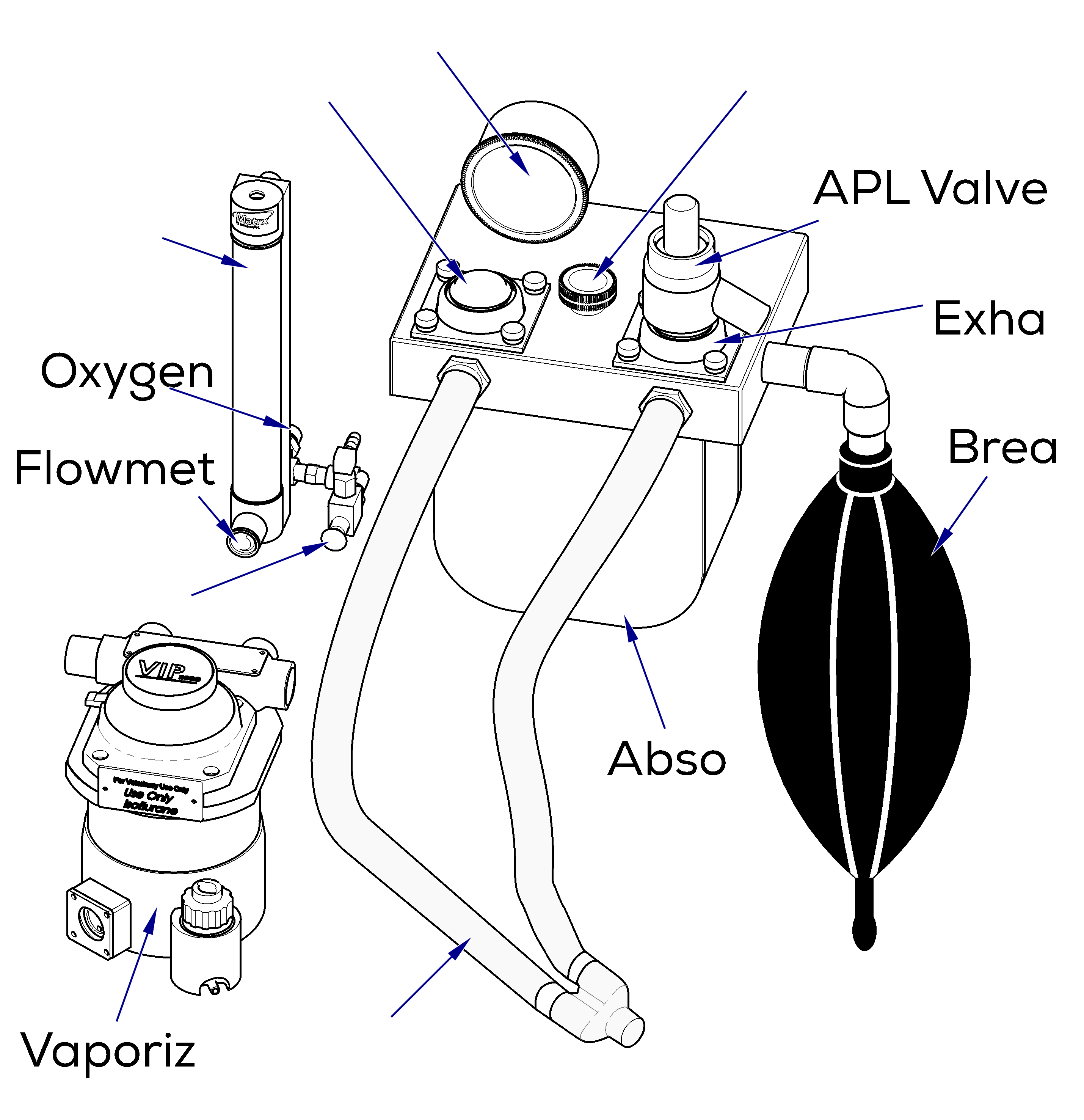
| Breathing Bag | |
|---|---|
| Patient Weight | Bag Size |
| 15 lbs or less (7kg) | 500 ml |
| 15-30 lbs (7-14 kg) | 1 liter |
| 30-60 lbs (14-27 kg) | 2 liter |
| 60-100 lbs (27-45 kg) | 3 liter |
| 100 + lbs (45 + kg) | 5 liter |
Ensure gas supplies are adequate and turned on. Verify vaporizer is filled to eliminate the possibility of anesthetic depletion during surgery.
Never invert or tilt the vaporizer when it contains anesthetic liquid. Never overtighten the flowmeter needle valves, damage to the needle and seat will eventually result. Using the flowmeter, pressure gauge, or pressure relief valve as handles when transporting can result in damage to components.
To Operate Anesthesia Machine
1.Loosen thumb screw to remove CO2 absorber canister. Fill canister with absorbent material, following directions on canister label. Be sure canister and gasket mating surface are completely free of absorbent. Replace canister in absorber assembly. Tighten thumb screw.
2.Connect breathing bag and breathing circuit.
3.Connect a 50-55 PSI (3.4-3.8 Bar) oxygen supply line to the oxygen supply fitting on the back of the flowmeter.
4.Adjust flowmeter and vaporizer settings to meet physiologic needs of the patient.
5.During anesthesia, monitor the pressure gauge, inhalation and exhalation valves, and the breathing bag. Make necessary corrections in flow rate, vaporizer setting, and Scavenging/Adjustable Pressure Limiting (APL) valve, to ensure adequate depth of anesthesia and adequate ventilation of the patient.
For guidelines on induction and anesthesia techniques, or particular species physiologic requirements, etc., please refer to a veterinary anesthesia textbook.
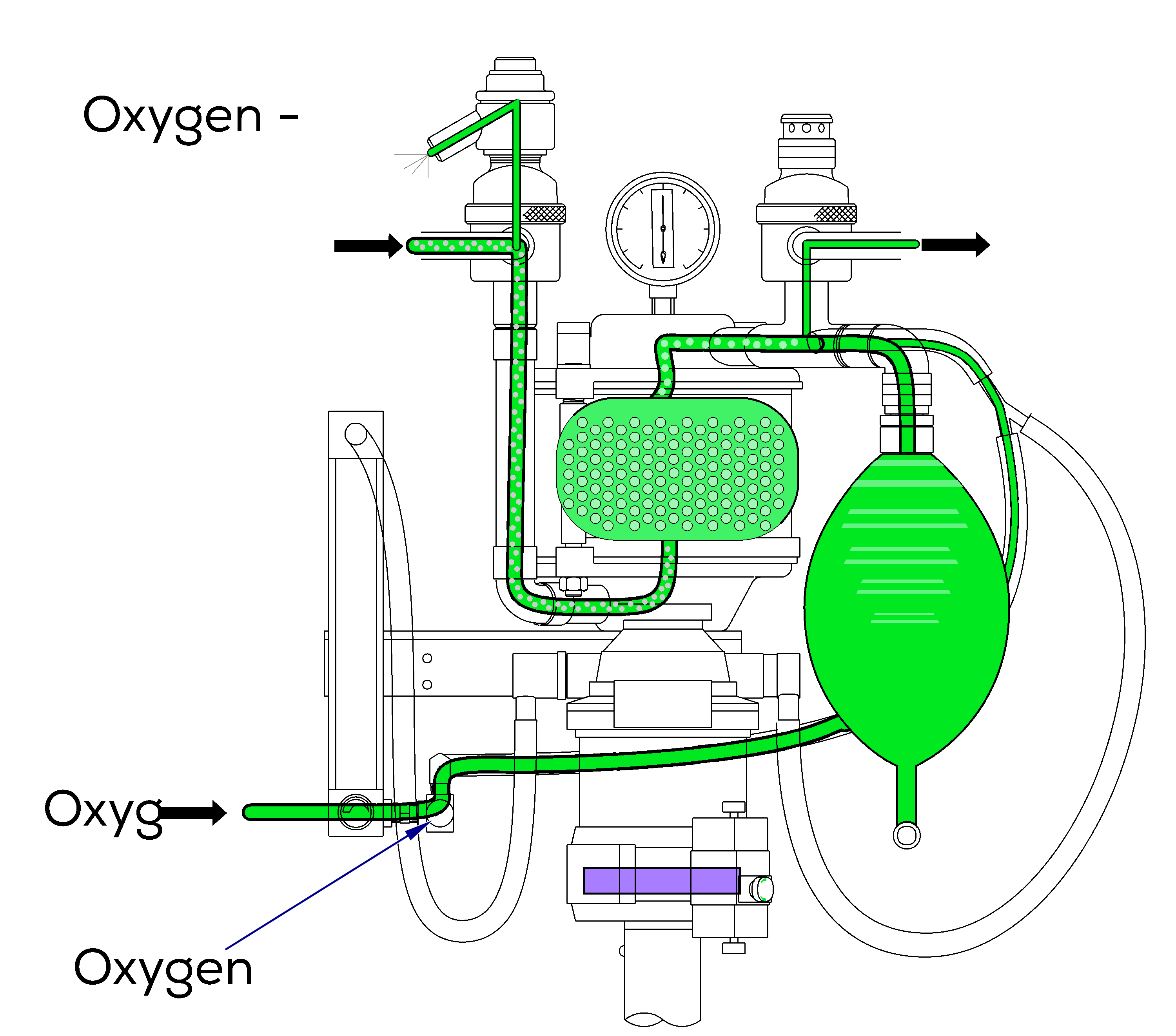
1.Oxygen enters the machine at the lower back of flowmeter.
2.Pressing the button on the oxygen flush valve bypasses the vaporizer.
3.Oxygen enters the reservoir bag and inhalation tube then is inhaled by the patient.
4.The patient exhales. Waste gas enters the machine.
5.Waste gas enters the CO2 absorber canister which removes the CO2.
6.Oxygen without CO2 enters the reservoir bag, inhalation tube and patient, recycling the oxygen.
7.A small amount of waste gas exits the APL valve, maintaining pressure in machine and patient’s lungs at 1-3cm H2O.
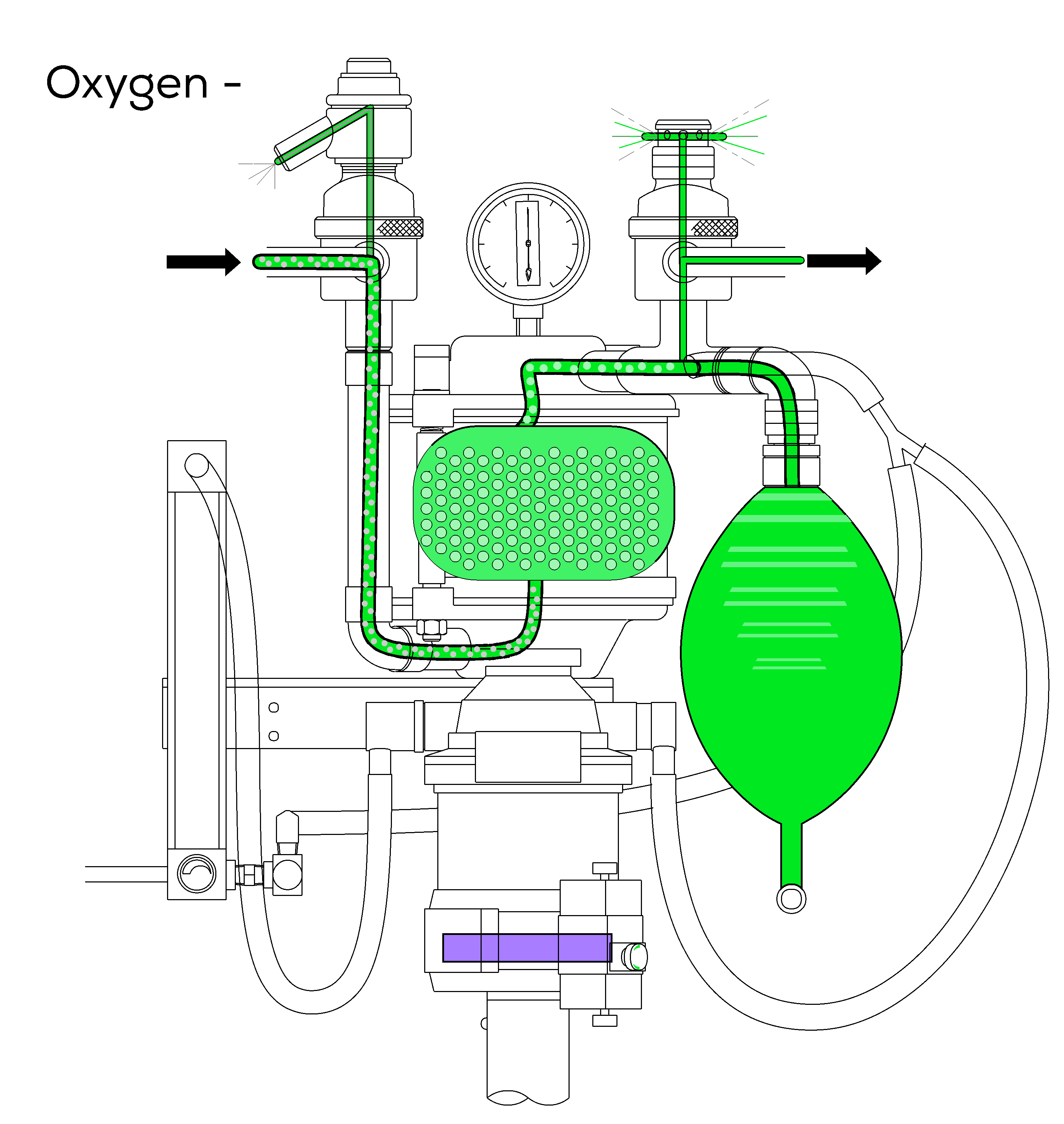
1.If there is no oxygen in the tank or the flow is shut of at the flow meter, room air enters the machine through the safety valve. The patient does not receive anesthetic gas.
2.During inhalation, the reservoir bag deflates first, then air from the safety valve is drawn into the system.
3.The patient exhales. Waste gas enters the machine.
4.Waste gas enters the CO2 absorber canister which removes the CO2.
5.Air without CO2 enters the reservoir bag, inhalation tube and patient, recycling the air.
6.A small amount of waste gas exits the APL valve.

